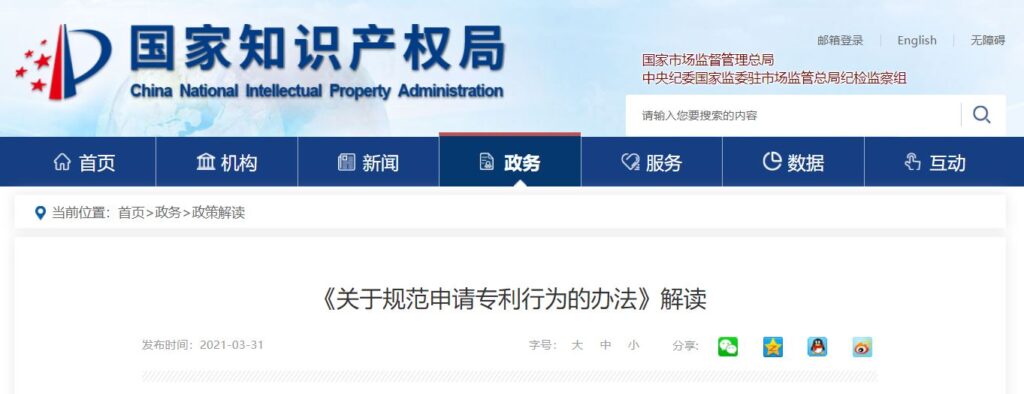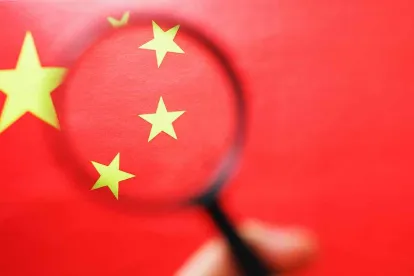The China National Intellectual Property Administration (CNIPA) released the “Measures Regarding the Regulation of Patent Applications” (关于规范申请专利行为的办法) on March 11, 2021. China is continuing the transition from quantity to quality in patent applications and one method is to reject ‘abnormal’ or ‘irregular’ patent applications as defined in the Measures. These measures and the concurrent elimination of monetary incentives for patent filings should decrease the total number of applications filed in China as quality increases. CNIPA itself is budgeting a potential 50+% drop in patent applications filings over three years.
To clarify the Measures, CNIPA on March 31, 2021 has released the
“Interpretation of the Measures Regarding the Regulation of Patent Applications” (《关于规范申请专利行为的办法》解读). The Interpretation clarifies the definition of irregular (or abnormal) patent applications; examination procedures for irregular patent applications; responding to a find of irregularity; and other measures. Of particular concern is item 3 below that may affect some IP holding companies by classifying their patent applications as irregular and CNIPA subsequently withdrawing them. The Interpretation also confirms that foreign-originated Chinese applications are subject to the Measures.

The Interpretation notes that list of what constitutes irregular applications in the Measures is non-exhaustive and further explains as follows in an unofficial translation:
1.”Multiple patent applications formed by the simple combination of features or elements of different inventions and creations with obviously identical contents or substantially different contents submitted simultaneously or successively” means that a plurality of patent applications are formed due to obviously identical contents of an invention or creation or after simple combination changes, and no matter whether the patent applications are submitted simultaneously or successively, the inventions or utility models include a plurality of applications for simple replacement or patchwork of different materials, components, proportions, parts, etc. Also the design applications obtained by simple assembly or replacement compared to the original or minor changes of different design features or elements. It should be pointed out in particular that “the contents of invention-creation are obviously the same” does not include the circumstance that the same applicant permitted by Article 9 (1) of the Patent Law applies for both a patent for utility model and a patent for invention for the same invention-creation on the same day.
2. Regarding “the submitted patent application has fabricated, forged or altered invention and creation content, experimental data or technical effects, or plagiarism, simple replacement, patchwork of existing technologies or existing designs and other similar situations,” fabricated, forged or alteration mainly refers to the act of fabricating or falsifying non-existent inventions and creations, experimental data, technical effects, etc.; or the act of exaggerating the effect after modifying and altering existing technology or design schemes, but the effect cannot actually be achieved.
3. Regarding “the inventions and creations of the submitted patent applications are obviously inconsistent with the actual research and development capabilities and resources of the applicants and inventors” means that the number or contents of inventions and creations in the submitted patent applications obviously exceed the actual research and development capabilities of the applicants and inventors. For example, a company has submitted a large number of patent applications in a short period of time, but it has been verified that the company has no personnel covered by social insurance and no paid-in capital. It is actually a shell company with no investment in scientific research, no R&D team, and no production and operation.
4. Regarding “The invention and creation content of multiple patent applications submitted is mainly randomly generated using computer programs or other technologies” refers to the fact that there is no actual participation of scientific researchers, and only computer methods are used to randomly and disorderly form technical plans or design plans. There is no real innovation activity. For example, the contents of multiple applications submitted are completely technical solutions, product shapes, patterns or colors randomly generated using computer technology.
5. “The invention-creation for which a patent application is submitted is an invention-creation which is deliberately formed for the purpose of evading patentable examination and does not conform to the normal principles of technological improvement or design, or which is inferior, piled, or unnecessarily reduces the scope of protection but has no search or examination significance” means that, from the perspective of a technician in the field, the applicant deliberately complicates what is conventional in the field or that can be realized in a simple step in the field for the purpose of evading patentability examination, but in fact does not improve the technology, especially the claims that are formed by listing a large number of minor or unnecessary technical features, and essentially needlessly reduces the scope of protection.
6. Regarding “to evade the regulatory measures against irregular patent applications, multiple patent applications that are substantially associated with a specific entity, individual or address are scattered, submitted one after the other or in different places.” refers to the purpose of avoiding being identified as an abnormal patent applicant by registering multiple companies, using multiple ID card numbers, or using multiple company addresses, the patent applications originally belonging to the same applicant are submitted separately varying by time, location, and applicant.
7. “Buying or selling patent application right or patent right without the purpose of implementing patented technology, design or any other justifiable purpose, or falsely modifying the inventor or designer.” It mainly includes two situations: first, the acts of buying and selling patent applications or patents for non-market competition purpose. For example, an institution or individual transfers patent applications or patents in batches, and the patent applications or patents held by the transferor are not necessarily related to its business; or the transferee obviously does not accept the patent application or patent for technical implementation or other reasonable legal purposes. Second, the acts of making false changes to the inventors or designers. In practice, it is found that there exists a circumstance where, for improper interests, the inventor or designer changes the person who has not made contribution to the invention or creation into an inventor or designer, and Rule 13 of the Implementation Rules of the Patent Law provides that the inventor or designer shall be the person who has made creative contribution to the substantive features of the invention or creation.
8. Regarding “patent agencies, patent agents, or other institutions or individuals, acting as agents, inducing, instigating, helping others or conspiring with them to implement various types of irregular patent applications” refers to qualified patent agencies and patents agents and institutions or individuals without patent agency qualifications carry out various types of irregular patent applications. Including the act of directly acting as an agent for abnormal patent applications, as well as the act of inducing, abetting, and helping others to file abnormal patent applications.
Regarding examination of irregular patent applications, the Interpretation states that irregularity can be determined at any stage: patent application acceptance, preliminary examination, substantive examination, and reexamination procedures, or in the international phase procedures of international applications. Once found, CNIPA will ask the applicant to withdraw the application giving the applicant a chance to respond with opinions and supporting materials. If CNIPA still believes the application is irregular, it will reject the application. If the applicant doesn’t respond, the application will be withdrawn.
If CNIPA makes a final determination of irregularity, an applicant can file for administrative reconsideration with CNIPA or filed an administrative lawsuit with a People’s Court (which will be the Beijing Intellectual Property Court).
Other clarifications include the All-China Association of Patent Attorneys shall administer self-discipline measures to both agents and firms for filing irregular applications and potential criminal charges if justified. For example, a government official in Sichuan was recently sentenced to prison for filing over 200 irregular applications.
The full text of the Interpretation is available here (Chinese only).



 />i
/>i

